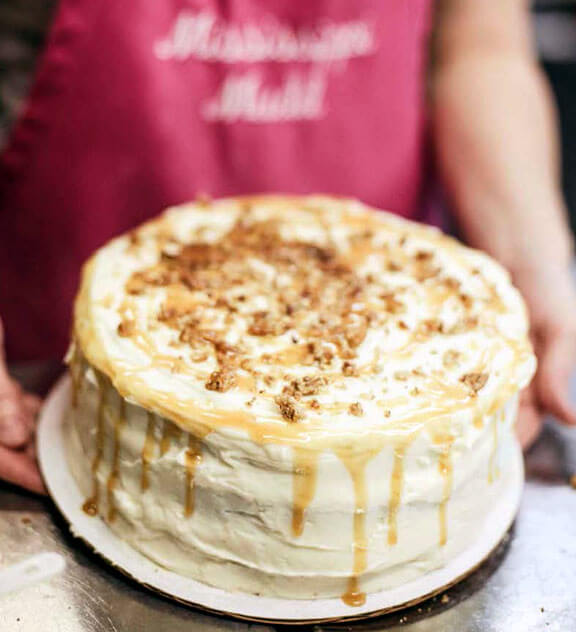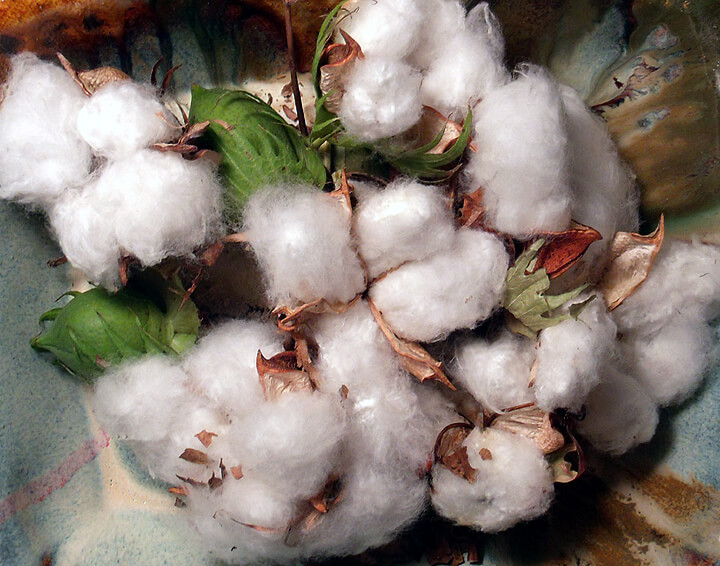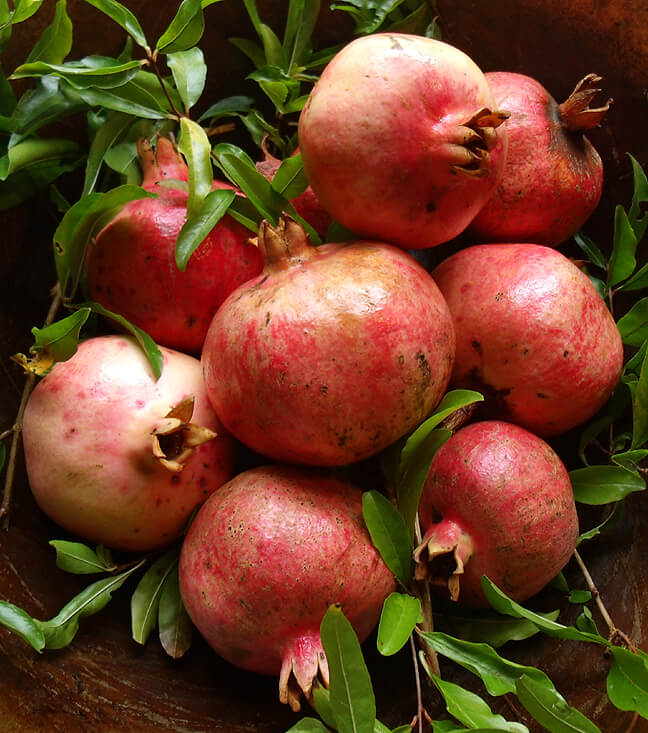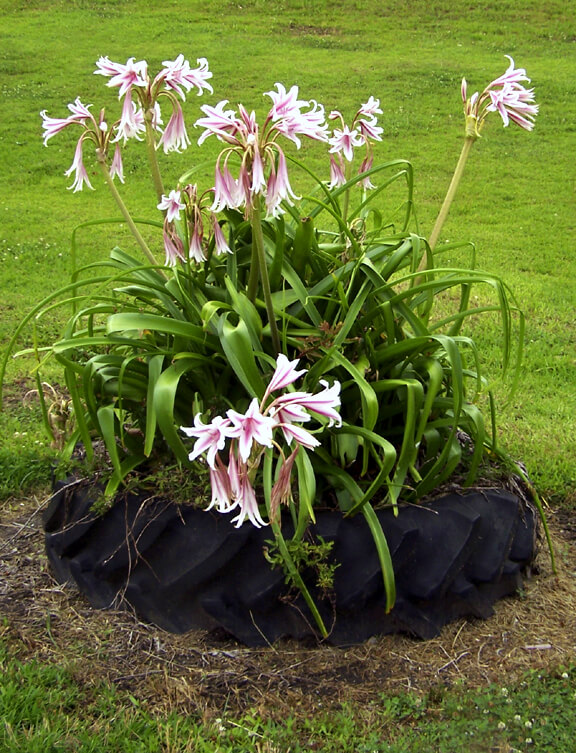A Culinary Classic from Water Valley
The B.T.C. Old-Fashioned Grocery Cookbook spotlights small town Main Street South and focuses on good, real people creating real good food and helping to make the world a better place. With this book the authors, entrepreneur Alexe van Beuren and chef Dixie Grimes, celebrate their home in north Mississippi. Like many towns in the rural South, Water Valley has languished; once busy squares and streets are lined with broken sidewalks and historic buildings are being sold for bricks. But in Water Valley, community is in focus, and though the B.T.C. Old-Fashioned Grocery has become a vibrant element in the town, Alexe and Dixie will be the first to tell you that the B.T.C. Grocery did not revive Water Valley: “Water Valley revived us.” Their book pulses with heart and glows with the warmth of their revival: a cornucopia of extraordinary food, exceptional writing and bountiful spirit.
The B.T.C. Old-Fashioned Grocery Cookbook often ranges far from the table, but first and foremost it is about food, beautiful food. Chef Dixie Grimes cut her teeth in local restaurants, and her talents are enriched by time. In the B.T.C. cookbook, Dixie’s foods can be divided into two broad categories: traditional Mississippi recipes, many she learned in the Oxford kitchen of her grandmother Vetra Stephens; and progressive dishes that are the product of years of experience and an exceptional feel for the ingredients and how they work together in any given recipe. Dixie says that the food of Mississippi is too easily overlooked or dismissed because of its simplicity and her respect for and propagation of the traditional ingredients and time-tested methods of Southern cooking are a dominant theme.
Any Mississippian, especially one from north Mississippi, will feel as if they’re at their own grandmother’s table with many of these dishes, or at any family reunion or church homecoming, where you’re bound to find such favorites as three bean salad, chicken spaghetti and sweet potato pie. Dixie includes a perfect cornbread recipe (yes, of course it has bacon grease), along with instructions on how to swipe your hot skillet with that grease before pouring in the batter. Such details distinguish a really good cookbook from one that’s simply rote recitation with pretty pictures. (Speaking of which, take it from someone who knows; food photography is tricky and takes a lot of care and thought. My hat is off to Ed Anderson for his beautiful work in The B.T.C Old-Fashioned Cookbook.)
With the corn bread recipe comes one for corn bread dressing, a Southern staple, along with a dictum for our fellow countrymen beyond the Mason-Dixon Line to understand that “There is no stuffing in the South.” Dixie makes her Thousand Island dressing with mayonnaise and chili sauce, tomato sauce, ketchup and other things just as everyone did before Wishbone. (Note: in central Mississippi, this same concoction is called “comeback”, and is used on anything you can put on a plate.) Yellow “crookneck” squash casserole is another summer standard, and let it be known that Dixie, like her fellow Mississippian Craig Claiborne, offers a chicken spaghetti recipe as well as one for pickled eggs. It is also altogether fitting and proper that the B.T.C. Old-Fashioned Grocery’s pimento and cheese is “red rind” cheese with pimento, which for me brings to mind the vivid image of a hoop of red rind cheddar sitting on the counter of a small country store under a wrap of wax paper ready to be sliced and eaten with saltines and a hunk of baloney or a can of Viennas. Being in Ole Miss’ back yard, of course the B.T.C. has a Hotty Toddy Beer Chili, which is a best-seller even when the Rebs aren’t slugging through the S.E.C.
When Dixie spreads her wings, magical dishes come to the table. Water Valley is in the Catfish Belt, and the book offers three recipes. One, with a nod to our neighbors in New Orleans (there’s a grillades recipe as well), is a blackened catfish that Dixie takes to higher ground with a Tabasco beurre blanc tanged with lime. This recipe is an exquisite example of what a top-rate chef who knows her methods and ingredients can do with a modern-day classic. Dixie’s honey pecan catfish is also a splendid work of innovation, and her catfish gumbo will stand up to any in the South. Her asparagus strawberry salad is an inspired combination of seasonal favorites, her watermelon salad (Water Valley’s Watermelon Carnival draws over twenty thousand people every year) is just brilliant, and her Brussels sprouts casserole is a winner. The roasted pear and zucchini soup was featured in The New York Times, so I’m pretty sure it’s good, too.
Chef Dixie shares the B.T.C. kitchen with sous chef Lori Ward, the Breakfast Queen of Water Valley, and with Cora Turnage Ray, the in-house baker and owner of Mississippi Mud Bakery. Cora, a native “Vallian” makes everything from scratch. Cora’s recipes tend to run to the traditional as they very well should in a small Mississippi town, with “old school” three-layer cakes such as coconut, strawberry and Lane, but she too breaks with tradition; her sweet potato pie rests in a rosemary crust, and her chess pie includes buttermilk. More notably, her “fried” pies are baked, “a practice that sets many an old-timer nodding and saying that’s how his or her mother did it,” resulting in light, flavorful pastries. But that’s not all; Alexe and Dixie put another leaf in their table by sharing the recipes of friends, neighbors and significant others. They include Coulter Fussell’s red beans and rice, Miss Vetra’s chicken noodle soup, Mrs. Jo Turnage’s banana pudding and Cliff Lawson’s hominy San Juan. Alexe’s husband, Kagan Coughlin, gets into the act with a pickle recipe, but Kagan’s biggest contribution is his renovation of the old building, which took five years and uncounted hours, working nights and weekends cleaning, moving stairwells, restoring thousands of square feet of heart pine flooring, throwing up walls, installing plumbing, building counters and hauling in appliances from all over north Mississippi. (Did I mention he makes pickles?) The writing is in Alexe’s voice; warm, often intimate, charming in its candor and gentle in its humor. The introductory essay, “Welcome to the B.T.C.”, sets the stage for an adventure. “Everybody Asks” explains what B.T.C. stands for (and more), and the three essays in the “Soup” section, “Winter”, “Summer”, and “Fall (a.k.a Football)” are delightful. My favorites are “Where Food Comes From”, “Friends and Neighbors”, “Let There Be Leeks: Brother Ken and Co.”, “Billy Ray Brown” and “Mississippi: A Long, Slow Seduction”, which offers a thought-provoking outsider’s view of my homeland.
The B.T.C. Old-Fashioned Grocery Cookbook stands out in the motley crew of current works on food with both recipes and writing, but what lifts the work to an even higher plane is that this book has voice, and not just one. Most cookbooks aren’t written so much as they are compiled by some editorial body with recipes and accompanying quotes from the purported author, who is usually some griddle Napoleon or oven Antoinette with a sufficiently high media profile to justify the printing costs. Unlike those efforts, this work isn’t eaten up with ego: there is no “I, me, my”; instead you find “we, us, and ours”. Any book of length written about food should mirror a time and place, and this work does all that in full. Alexe and Dixie set out to write about “the magical place where we have found ourselves” and “to give back to the people and community that has given us so much”, echoing a welcome spirit unheard in a very long time, a spirit of independence, enterprise and love.
Yancy Cotton
Wild Pomegranates
Old Magnolia
Tire Lilies
Jackson Skyline South
Wood Street Church
A Calhoun County Slave Narrative
The WPA Slave Narratives consist of 3,500 relatively brief oral histories (most of them two to four pages long), representing about 2 percent of all ex-slaves surviving in the late 1930s. The sample for Mississippi was somewhat smaller: out of perhaps 20,000 living former slaves, 450 were interviewed by the WPA. All states and territories that had slaves in 1865 are represented, except Louisiana which did not participate.
Unfortunately, the quality of the interviews rarely matched the quantity. Few of the WPA interviewers were adequately trained. With the rarest exceptions, the interviews were not tape recorded and the finished transcripts were not so much word-for-word representations of what ex-slaves actually said, but reconstructions based on the interviewers’ memory or field notes. Nearly all of the interviewers were white Southerners and most of them were women. Far too often the tone and even the content of the interviews reflected the white supremacist values of the 1930s. The WPA workers often patronized or insulted the ex-slave interviewees, reconstructing their speech in the crudest “plantation style,” referring to them as “old darkies,” or as “auntie” and “uncle.” Too often interviewers accepted Old South mythology as truth, assuming that all slaves were contented, all masters kind, and all plantations idyllic.
Not surprisingly, during the interview process former slaves often seemed uncomfortable and cautious, eager to please their interviewers by supplying the “right answers” and by wearing the mask of racial submission. Yet some of Mississippi’s former slaves spoke so bluntly about harsh conditions and cruel treatment that state FWP officials, apparently offended by such candor, chose to violate WPA guidelines and not forward their narratives to the Library of Congress in Washington. Thousands of pages of “bad” slave memories were discovered in the Mississippi Department of Archives and History in the 1970s.
(From “WPA Slave Narratives” by Dr. Neil R. McMillen professor emeritus of history, the University of Southern Mississippi, posted February 2005 in Mississippi History Now, a publication of the Mississippi Historical Society)
Ike Woodward
I was born in Calhoun County at Pittsboro July 4, 1855. My papa was Nelson Woodward who was born in Richmond, Va., an’ my Mama was Dolly Pruitt from Alabama. My brothers was Jeff, Sam, Ben an Jim an my sisters was Tilla, Lena an’ Rosetta. “My job durin’ de war was to lead (blind) Bob Conner all through de war. You know Massa Conner was de papa of Mr. Fox Conner who is now such a big man in de’ army. “We belonged to de Wiley Woodward family but Mr. Wileys brother, Ike, was administrator for de estate after Mr. Wiley’s brother killed him. He lent me out to take de job of leadin’ Mr. Conner in de war. “Course I didn’ make no money workin for Mr. Conner. Money is one thing us niggers didn’t see.
My Missus, Massa Wileys wife had a son John Woodward. Dey was 690 acres on de Woodward plantation. I just don’t know how many of us niggers he owned but he was said to be de biggest slave owner in dis part of de country. De white folks sho’ didn’t ‘low us niggers to see a newspaper or nothin we might learn to read an ‘rite from. We went to de white folks church to worship an’ sometimes us niggers would hold meetings of our own at our quarters. White folks read ‘de Bible to us at Massa Conner’s on Sunday mornin’.
One slave we called Alex Woodward ran away lots o’ times an’ de white folks would have to catch him with bull dogs. Dey always used de “Bull Whip” on him when dey caught him. Major Woodard was good ’nuff to give ‘de slaves truck patches that dey could work Sunday, Sunday nights or any other moonlight nights but dey sho must be ready for their regular work on Monday mornin an’ work through Saturday evenin’.
Lots o’ times dey would scare us chillun with homemade ghosts. When slaves got sick a “Granny” would look after ’em. Us niggers sho’ did get good treatment when we was sick. You know white folks sho didn’t want a nigger o’ theirs to die—they was worth somethin! Back then if de white folks did let us niggers go anywhere they would write us a pass describin’ who we belonged to, our name, description an’ where we was goin’, cause some white folks might take us up thinkin’ we was a run-a-way slave.
When dem Yankees come through from de north travelin’ south dey stole lots of de wealthy peoples good stock an’ left their ole wore out plugs in their places. When de war was over didn’t nobody at Massa Conners tell us niggers we was free. One mornin’ several days after de 8th o’ May de white folks sent me to de well down in de valley below de house to get a bucket o’ water. When I started to draw de water I saw my brother comin through de woods ridin a blazed face mare. He never said a word but galloped to de well, picked me up an put me on de horse with him an’ carried me from Massa Conners to de Woodwards. Massa Woodward had told my papa if he’d stay on with him an’ work when crops was gathered he’d give him half we made, so we did.
I has been married twice. My first wife was July Wade, we married when I was 17 years old and we had 10 chillun. Carrie Bell lives close to Calhoun City, Sammie Lee she lives there close by an de others are scattered about in other states. Most of ’em farms. My next wife was Lizzie Moore an’ we ain’t got no chillun. Young people now have better times.
Stalking Jezebel
Most recipes named for a person tend to have documented pedigrees; we can trace bananas Foster, Melba toast and chicken tetrazzini to a particular person and chef in a particular restaurant. But Jezebel sauce is an orphan. Jezebel herself was a 9th century BCE Phoenician princess known best as the wife of Ahab, King of Israel, who she converted to the worship of the Lord of the Flies. Her foe Elijah, speaking through the prophet Elisha, brought about her downfall, and it’s because of her idolatry and animosity towards Hebrew prophets (she had a number of them killed) that she is remembered as a voluptuous temptress who led the righteous Ahab astray. While Jezebel’s association with sexual promiscuity is of more recent vintage (e.g. Frankie Laine’s 1951 hit “Jezebel”), it’s usually taken for granted that this cloying reputation led to the naming of this blend of sweet condiments mixed with pungent horseradish. Jezebel sauce is most often served with ham, pork or other meats such as roast beef or smoked turkey, but is sometimes poured over cream cheese for use as a cocktail dip with crackers.
Biblical precedent aside, the sauce’s parenthood is shrouded. In response to a query about Jezebel’s culinary origins, Liz Williams, President and Director of the Southern Food and Beverage Museum, said, “You are asking about one of those mysterious things in food. I think that most people agree that Clementine Paddleford’s is the first written reference to the sauce as Jezebel sauce in the mid-1950s. Other than that, I do not know. Fruit sauces mixed with horseradish existed before, but were not called Jezebel sauce.” The delightfully-named Clementine was an American food writer active from the 1920s through the 1960s, writing for the New York Herald Tribune, the New York Sun, and the New York Telegram, among others. Paddleford’s recipe for Jezebel sauce is in her landmark work, How America Eats (1960), though she may well have written about it elsewhere before then.
Gary Saunders of DixieDining.com (“May the Fork Be with You!”) says, “Jezebel sauce is a spicy sauce (like Jezebel herself) that contains pineapple preserves, apple jelly, horseradish, and mustard. The Jezebel sauce (or glaze) is often served over ham. A Southern origin of this dish seems certain, with Kansas, Louisiana, Mississippi, and Florida all putting in claims.” He then cites recipes from the Syracuse (NY) Post-Standard, 26 October 1958, “‘Mrs. Kansas’ Is a Cooking Whiz: Treats from the Sunflower State,” This Week magazine; the Pontiac (IL) Daily Leader, 21 November, 1967; and the Elyria (OH) Chronicle-Telegram. This last source states that the recipe is from Sunny Side Up, “the excellent cookbook published by the Junior League of Fort Lauderdale, Fla.”
More confusingly, Andrea Yeager, in an August, 2005 article in the Biloxi Sun Herald, “On the Trail of Jezebel Sauce”, writes, “Is Jezebel sauce a Mississippi creation? Rodney Simmons of Bell Buckle Country Store in Tennessee wants to know. His company recently began producing Jezebel sauce, and he would like to know the origin of the sauce. He has traced the recipe’s history to the Gulf Coast. “I thought it was Creole or Cajun, but after a recent conversation with Paul Prudhomme, we think that it originated on the Mississippi Gulf Coast, around Gulfport.” (Simmons doesn’t fully recount the conversation.) As a native son proud of his state’s culinary heritage, I’d like to think that Jezebel sauce originated in Mississippi, but I suspect it originated in the Midwest. This Jackson recipe is from the splendid The Southern Hospitality Cookbook by Winifred Greene Cheney, who claims, “Some of this sauce would have made Ahab’s wife a better woman.” I doubt it; Jezebel was a real bitch.
Fidelia’s Jezebel Sauce for Pork
1 (16-ounce) jar of pineapple preserves, 1 (12-ounce) jar apple jelly, 1 (6-ounce) can prepared mustard (I use a brown, jly), 1 (5-ounce) jar horseradish, salt and freshly ground pepper. Blend all ingredients with an electric mixer. This sauce keeps well refrigerated in a sealed container. Yield: 3 cups.










